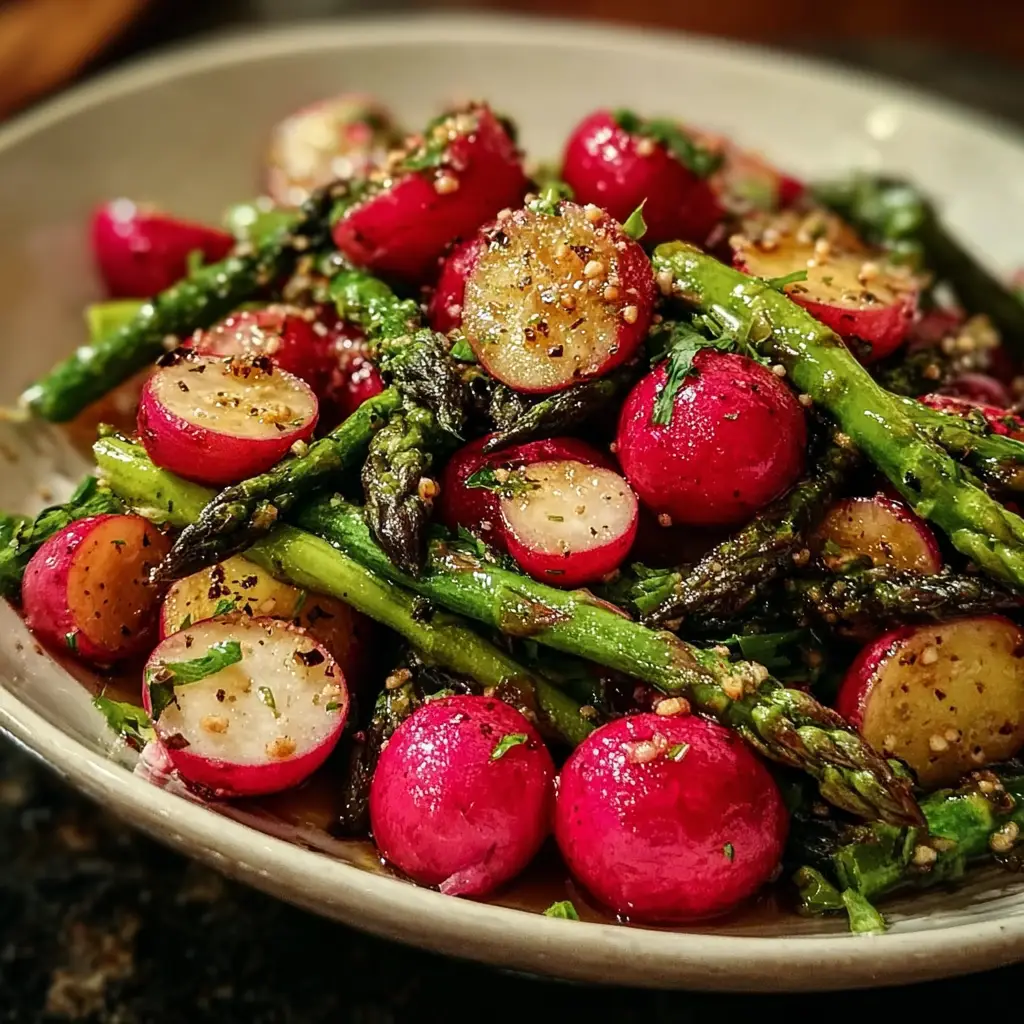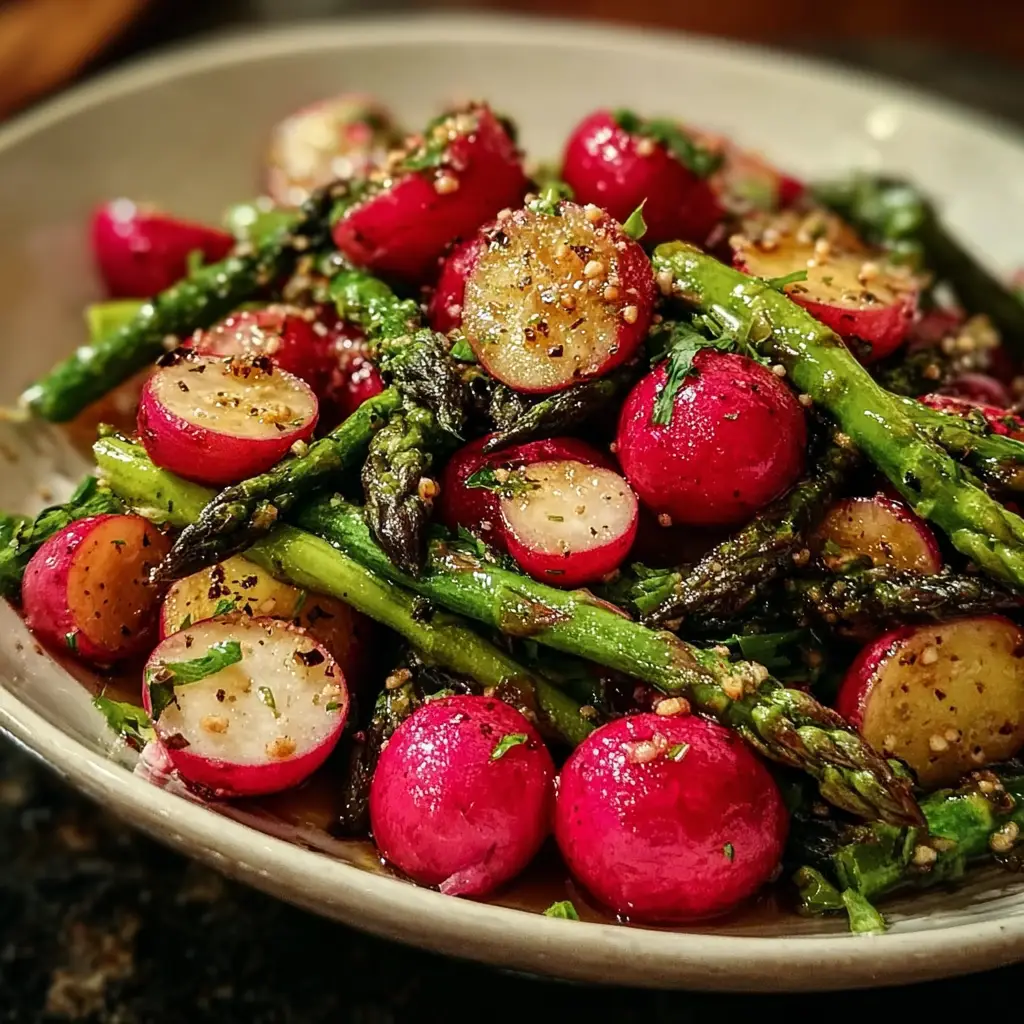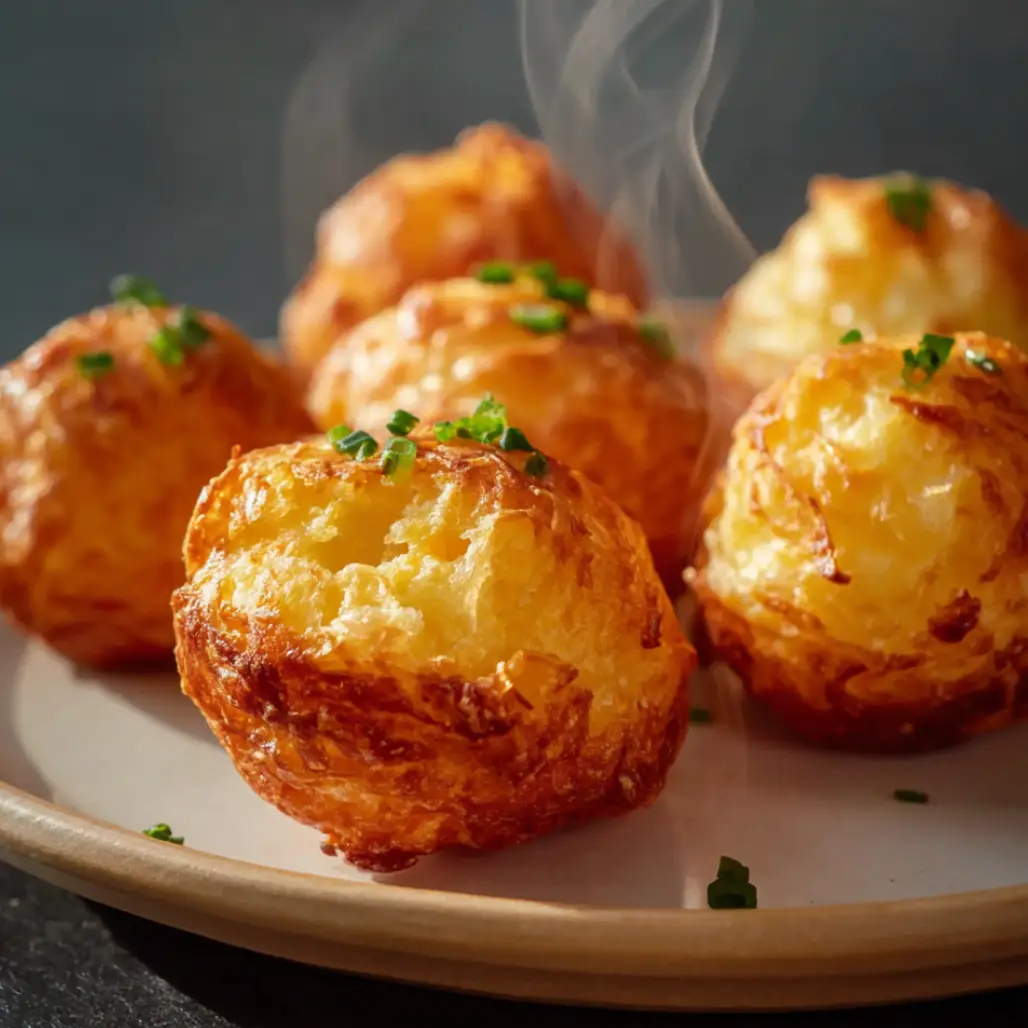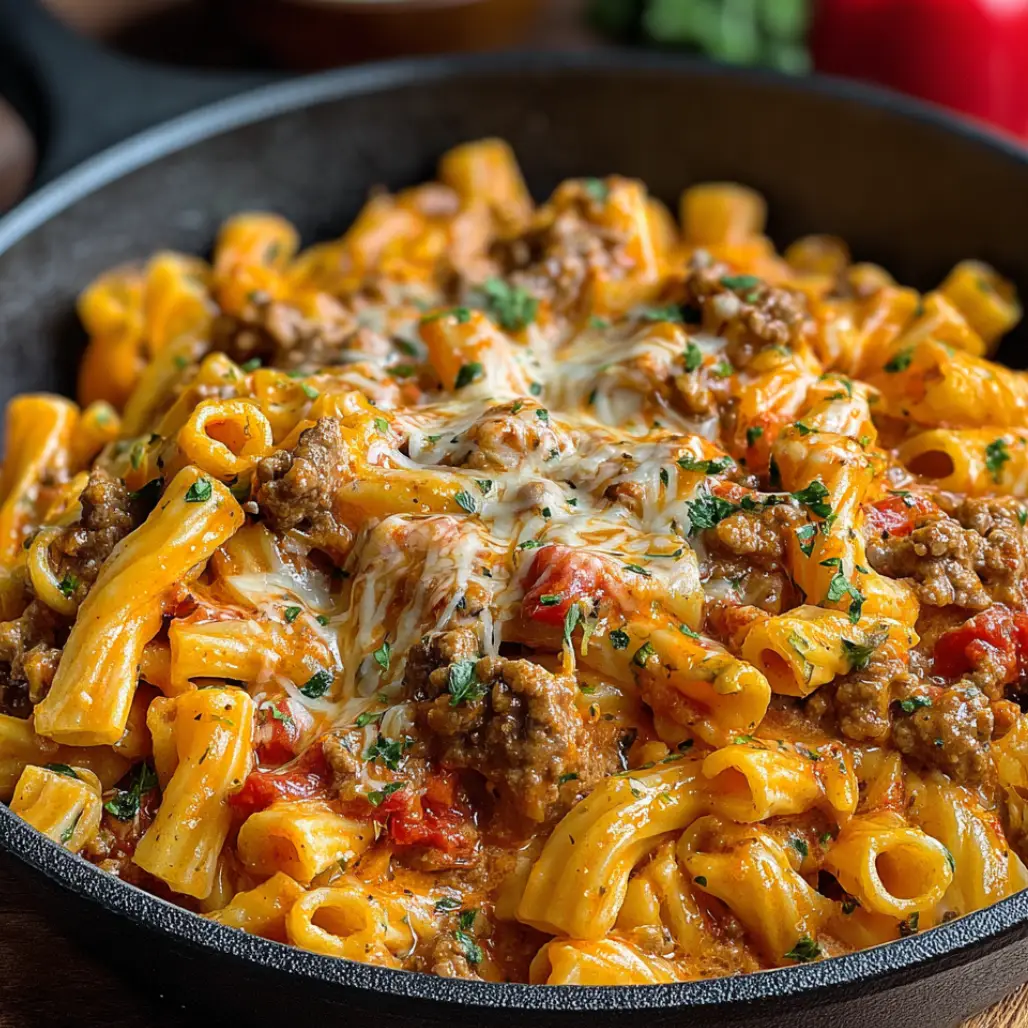| Prep Time: 20 minutes | Cook Time: 25 minutes | Total Time: 45 minutes | Serves: 8 |
Experience the sophisticated elegance of spring dining with this exceptional preparation that elevates humble vegetables into a culinary masterpiece because this carefully crafted recipe demonstrates how proper roasting techniques and thoughtful flavor pairing can transform ordinary asparagus and radishes into something truly extraordinary. This refined side dish represents the perfect marriage of seasonal abundance and culinary artistry, showcasing how a bright, tangy mustard vinaigrette can unite disparate elements while creating harmony that satisfies both visual and gustatory senses in ways that celebrate the renewal and vitality of spring.
The Revolutionary Appeal of Unexpected Vegetable Combinations
What distinguishes this preparation from conventional vegetable dishes is its bold approach to combining ingredients that might seem incompatible because roasted radishes undergo a remarkable transformation that surprises even experienced cooks who understand their potential. The process mellows their characteristic sharpness while developing sweet, earthy notes that complement asparagus beautifully, creating complex flavor profiles that evolve throughout the eating experience while challenging preconceptions about these often-underutilized vegetables.
The mustard vinaigrette serves as the culinary bridge that unites these transformed vegetables because its bright acidity and aromatic complexity enhances each component while providing the textural contrast and flavor punctuation that elevates the entire dish. This sophisticated approach to vegetable cookery demonstrates how professional techniques can be adapted for home kitchens, delivering restaurant-quality results that impress guests while building confidence in adventurous cooking that celebrates seasonal abundance.Roasted Asparagus
Premium Ingredients for Exceptional Results
2 1/2 pounds medium asparagus spears, uniform thickness for even cooking 1 1/4 pounds mixed radishes, including watermelon and cherry varieties for color 1/3 cup premium olive oil, divided between roasting and vinaigrette preparation 3 tablespoons whole grain Dijon mustard, for textural interest and complex flavor 1/4 cup champagne vinegar, or white wine vinegar for delicate acidity 2 tablespoons pure maple syrup, Grade A dark robust for complex sweetness 2 large shallots, minced finely for aromatic foundation and subtle onion notes 3 cloves garlic, minced fresh for pungent warmth and depth 2 teaspoons fresh rosemary, chopped finely for pine aromatics 1 teaspoon kosher salt, plus additional for seasoning vegetables before roasting 1/2 teaspoon coarsely ground black pepper, plus extra for finishing touches 3 tablespoons fresh chives, chopped for bright color and mild onion flavor 2 tablespoons fresh dill, chopped for aromatic complexity and spring freshness Coarse sea salt, for final seasoning and textural enhancement Roasted Asparagus
Mastering the Craft of Sophisticated Vegetable Cookery
Creating exceptional results requires understanding the fundamental principles of how different vegetables respond to high-heat cooking because achieving restaurant-quality outcomes depends on recognizing the optimal timing and temperature combinations that maximize flavor development while preserving textural integrity. This knowledge guides decisions about preparation sequence, seasoning application, and monitoring techniques that ensure each component reaches its peak potential while contributing harmoniously to the overall composition.
The approach involves systematic development of flavors through proper ingredient preparation and strategic cooking methods that respect the individual characteristics of each vegetable while encouraging beneficial interactions between complementary elements. This understanding informs timing decisions, temperature management, and finishing techniques that create professional-level results while maintaining the fresh, vibrant qualities that define exceptional spring cuisine.
Roasted Asparagus
Comprehensive Step-by-Step Preparation Guide
Establishing the Optimal Foundation
Preheat your oven to 450°F and position racks in the upper and lower thirds to accommodate multiple baking sheets if necessary because higher temperatures promote better caramelization while proper rack positioning ensures even heat distribution throughout the cooking process. Select the finest asparagus available, looking for firm spears with tight tips and minimal woody stems, then snap off the tough ends where they naturally break to ensure uniform cooking and optimal texture in your finished preparation.
Professional Tip: Choose asparagus spears that are roughly the same diameter to ensure even cooking, and avoid pencil-thin varieties that may overcook before the radishes reach optimal tenderness.
Roasted Asparagus
Key Points: Quality ingredient selection directly impacts final results, while proper oven preparation ensures optimal cooking conditions that promote even browning and prevent hot spots that could cause uneven doneness.
Preparing Radishes for Optimal Transformation
Examine each radish carefully, selecting firm specimens without soft spots or excessive blemishes, then trim tops and roots before washing thoroughly under cold running water because clean vegetables develop better flavors and more attractive appearances during the roasting process. Cut larger radishes into halves or quarters depending on size, while leaving smaller ones whole to create visual interest and varied textures that enhance the overall eating experience and presentation appeal.
Professional Tip: Reserve any tender radish greens for use in salads or as garnish, as they provide additional color and flavor opportunities that complement this preparation beautifully.
Key Points: Uniform sizing ensures consistent cooking across all pieces, while thorough cleaning removes any gritty elements that could affect the final texture and overall enjoyment of the finished dish.
Creating the Perfect Seasoning Foundation
Roasted Asparagus
Arrange the prepared vegetables on large rimmed baking sheets, ensuring adequate spacing between pieces to promote proper air circulation and browning because overcrowding leads to steaming rather than roasting, which prevents the caramelization essential for developing complex flavors. Drizzle with 3 tablespoons of olive oil, then season generously with kosher salt and freshly ground black pepper, tossing everything together with clean hands to achieve even coating while being gentle with delicate asparagus tips.
Professional Tip: Use separate baking sheets if necessary to avoid overcrowding, as proper spacing is crucial for achieving the caramelization that defines exceptional roasted vegetables.Roasted Asparagus
Key Points: Even oil distribution promotes uniform browning while preventing sticking, and proper seasoning at this stage builds the flavor foundation that supports all subsequent taste development during cooking.
Optimizing the Roasting Technique
Sprinkle the minced garlic and fresh rosemary over the seasoned vegetables, distributing evenly to ensure aromatic complexity throughout the dish because these aromatics infuse the vegetables with additional flavor layers while roasting. Place the baking sheets in the preheated oven and roast for 20-25 minutes, rotating the pans halfway through cooking to ensure even browning and monitoring carefully for optimal doneness indicators.
Professional Tip: Check the vegetables after 15 minutes and adjust timing based on their progress, as oven variations and vegetable sizes can affect cooking times significantly.
Key Points: Strategic herb and garlic placement ensures even flavor distribution, while careful monitoring prevents overcooking that could compromise texture and visual appeal of your roasted asparagus and radishes with mustard vinaigrette.
Crafting the Signature Mustard Vinaigrette
Roasted Asparagus
While the vegetables roast, combine the whole grain mustard, champagne vinegar, maple syrup, and minced shallots in a medium mixing bowl, whisking vigorously until the mixture achieves smooth consistency because proper integration of these base ingredients creates the foundation for a stable, flavorful dressing. Gradually add the remaining olive oil in a thin stream while whisking continuously, creating a glossy emulsion that balances sweet, tangy, and aromatic elements perfectly.
Professional Tip: Allow the completed vinaigrette to rest for 10 minutes before serving to let the flavors meld and develop greater complexity and depth.
Key Points: Proper emulsification technique creates a stable dressing that maintains its consistency and flavor balance, while resting time enhances the integration of all flavor components for optimal taste development.
Final Assembly and Professional Presentation
Remove the roasted vegetables from the oven when they appear golden brown and tender, with asparagus showing slight char marks and radishes easily pierced with a fork because these visual and textural cues indicate optimal doneness and flavor development. Transfer the vegetables to a large serving platter, arranging them attractively to showcase the natural colors and textures, then drizzle with the prepared mustard vinaigrette while the vegetables are still warm to maximize flavor absorption.Roasted Asparagus
Professional Tip: Garnish with fresh herbs just before serving to maintain their vibrant color and aromatic impact, and provide additional vinaigrette on the side for guests who prefer more dressing.
Key Points: Proper timing of assembly preserves optimal temperature and texture while warm vegetables better absorb the vinaigrette flavors, and attractive presentation enhances the overall dining experience and visual appeal.
Expert Techniques for Professional Results
Temperature precision throughout the cooking process determines the success of this dish because vegetables require specific heat levels to develop proper caramelization without overcooking, which demands understanding your oven’s characteristics and adjusting accordingly. Invest in a reliable oven thermometer to ensure accuracy, as many home ovens run significantly hot or cold, affecting both cooking times and final quality of your roasted vegetables.
Timing coordination becomes crucial when preparing multiple components simultaneously because the vinaigrette benefits from resting time while vegetables require immediate attention to prevent overcooking. Plan your preparation sequence to allow vinaigrette completion before vegetables finish cooking, ensuring smooth service while maintaining optimal temperature and texture for the best possible dining experience.
Creative Adaptations and Seasonal Enhancements
Transform this base recipe throughout the spring and early summer by incorporating other seasonal vegetables such as baby turnips, young carrots, or spring onions that complement the asparagus and radish foundation while adding visual and flavor diversity. Consider different vinegar options such as balsamic, red wine, or herb-infused varieties that create unique flavor profiles while maintaining the bright, acidic character essential to this preparation’s success.Roasted Asparagus
Regional adaptations can reflect local ingredient availability and cultural preferences, such as adding Mediterranean herbs like oregano and thyme, or incorporating Asian elements like sesame oil and rice vinegar for fusion variations that maintain the core principles while exploring different flavor territories that appeal to diverse palates and culinary traditions.
Strategic Pairing Recommendations for Complete Meals
This sophisticated preparation enhances a remarkable range of spring and summer dining experiences because its bright flavors and elegant presentation complement both casual and formal meal occasions while providing nutritional value and visual appeal. Serve alongside grilled salmon, roasted lamb, or herb-crusted chicken where the acidic vinaigrette provides palate-cleansing contrast to rich proteins while the vegetables add color and freshness that enhances overall meal satisfaction.
The dish also excels when featured in our dessert recipes for complete menu planning that showcases seasonal ingredients across multiple courses, and pairs beautifully with selections from our snacks appetizers category for sophisticated entertaining that celebrates spring produce while demonstrating culinary creativity and attention to detail.
Expand Your Culinary Expertise
Deepen your understanding of advanced vegetable preparation by exploring our comprehensive breakfast favorites collection, where similar attention to ingredient quality and preparation technique creates memorable morning meals that showcase seasonal produce. The skills developed through mastering this roasted preparation translate beautifully to other cooking methods that emphasize proper technique and ingredient respect while building overall culinary confidence.
Our extensive dinner recipes selection provides inspiration for creating complete meal experiences that incorporate sophisticated vegetable preparations as integral components of memorable dining that showcases the versatility and appeal of plant-based ingredients when treated with proper respect and technical skill.Roasted Asparagus
Advanced Storage and Preparation Strategies
Maintain optimal quality through strategic preparation and storage techniques that preserve both flavor integrity and visual appeal because proper handling ensures your roasted asparagus and radishes with mustard vinaigrette remains at peak quality throughout extended entertaining periods or meal planning applications. Store cooled vegetables covered in the refrigerator for up to four days, though peak texture and flavor occur within the first 48 hours when vegetables maintain their appealing consistency.
Separate storage of the vinaigrette allows for flexible serving options and extended shelf life because the dressing maintains quality for up to one week when properly stored in a sealed container. This approach enables advance preparation for entertaining while ensuring optimal flavor balance and textural appeal when ready to serve, making this dish ideal for meal planning and sophisticated dinner party menus.Roasted Asparagus
Understanding the Advanced Science
The chemistry of vegetable roasting reveals why high temperatures create superior flavors because the Maillard reaction develops complex compounds that add depth and richness impossible to achieve through other cooking methods, while caramelization of natural sugars creates sweet notes that balance earthy flavors. Understanding these processes explains why proper spacing, temperature control, and timing are crucial for achieving restaurant-quality results in home kitchens.
The transformation of radishes during roasting involves the breakdown of glucosinolates responsible for their characteristic bite, resulting in milder, sweeter flavors that make them more appealing to broader audiences while maintaining their nutritional benefits. This scientific knowledge guides technique decisions and helps predict outcomes while troubleshooting potential issues that might arise during preparation.Roasted Asparagus
Solving Advanced Preparation Challenges
Address uneven cooking by evaluating oven hot spots and vegetable sizing because inconsistent results typically stem from temperature variations or pieces that are too different in size to cook evenly. If this occurs, use an oven thermometer to verify temperature accuracy and consider rotating pans more frequently while ensuring uniform cutting that promotes consistent doneness across all vegetables.
Prevent vinaigrette separation by maintaining proper emulsification technique and ingredient temperatures because failed dressings often result from oil addition that’s too rapid or components that are too cold to integrate properly. Master the gradual oil incorporation method while ensuring all ingredients are at room temperature for optimal emulsification success and long-term stability.
Additional Creative Inspirations
Explore the versatility of roasted vegetable preparations by investigating our flavored dips marinades collection, where similar principles of acid balance and herb integration create memorable flavor combinations that complement various cooking applications. The vinaigrette techniques learned through this preparation translate effectively to other dressing applications while building overall sauce-making competence.Roasted Asparagus
Consider incorporating elements from our refreshing beverages selection when planning complete spring menus that highlight seasonal ingredients across multiple courses and beverage pairings. These resources provide inspiration for developing comprehensive entertaining skills that showcase the relationship between food and beverage pairing in creating memorable dining experiences.Roasted Asparagus
Conclusion
This roasted asparagus and radishes with mustard vinaigrette represents the evolution of vegetable cookery from simple side dish to sophisticated culinary statement because it demonstrates how proper technique and thoughtful flavor development can transform humble ingredients into memorable experiences that challenge expectations while delivering genuine satisfaction. The recipe showcases the incredible potential of spring vegetables when treated with respect and enhanced through complementary preparations that honor their natural characteristics.Roasted Asparagus
The lasting value lies in its ability to educate palates while providing Roasted Asparagus practical skills that translate to countless other preparations, proving that exceptional vegetable cookery emerges from understanding ingredient behavior and applying appropriate techniques that maximize both flavor and nutritional value. Whether served at intimate family gatherings or elegant dinner parties, this preparation consistently delivers the kind of positive experience that creates lasting memories and establishes the cook’s reputation for providing thoughtful, delicious food that honors both tradition and innovation in contemporary cuisine.










